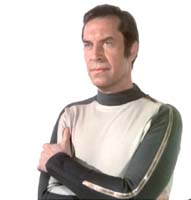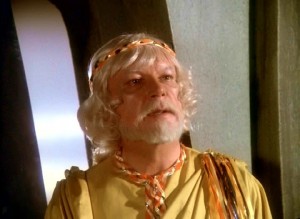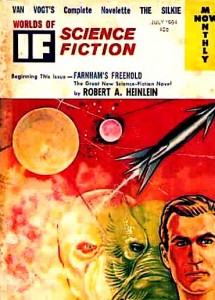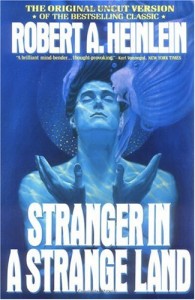So last week I gave a rundown of how four different SF stories used cannibalism in their plots. Most prominent were the first few episodes of this season of The Walking Dead, less obvious was an episode of the almost-forty-year old Space:1999 series called “Mission of the Darians.” Less well-known to those who think science fiction was invented in 1966 by Gene Roddenberry are two of Robert Heinlein’s works, Stranger in a Strange Land and Farnham’s Freehold.
All use cannibalism as a metaphor. In the two TV storylines, it’s a metaphor for denial of the importance of the individual. In Freehold, it’s a metaphor for oppression of one group by another. In Stranger, it’s a metaphor for strangeness, alien-ness, and acceptance of the universe. It’s also used as a gentle poke at Western Christians who consider themselves more civilized than the heathens who go around rubbing blue mud in their bellies.
 Rick Grimes and John Koenig, each the leaders of a ragtag band of wandering disaster survivors, confront very similar leaders of cannibal culture, what Walking Dead writer/producer Scott Gimple calls “institutional evil.” In both cases, the practice of feeding off other humans (emphasis on “other”) has been ingrained into a way of life, and those responsible for carrying it forward have so mechanized the practice that it’s hard to pin down exactly who is committing murder. If that sounds a bit like the hackneyed Nazi claim that individual soldiers were “just following orders” in the concentration camp, it’s not a coincidence. At least in the case of “Mission of the Darians,” writer Johnny Byrne has gone on record saying the Darians were patterned in part on the Nazis.
Rick Grimes and John Koenig, each the leaders of a ragtag band of wandering disaster survivors, confront very similar leaders of cannibal culture, what Walking Dead writer/producer Scott Gimple calls “institutional evil.” In both cases, the practice of feeding off other humans (emphasis on “other”) has been ingrained into a way of life, and those responsible for carrying it forward have so mechanized the practice that it’s hard to pin down exactly who is committing murder. If that sounds a bit like the hackneyed Nazi claim that individual soldiers were “just following orders” in the concentration camp, it’s not a coincidence. At least in the case of “Mission of the Darians,” writer Johnny Byrne has gone on record saying the Darians were patterned in part on the Nazis.
Gimple says you can’t get angry at institutionalize evil. Not sure I agree. We certainly got angry at the Nazis. We got angry at the Catholic Church when we felt it was enabling pedophilia. We got angry at Penn State when we felt its administration was turning a blind eye to rape. (Well, some of us got angry. And some of us were willing to see a few kids’ innocence sacrificed on the altar of professional athletics.) But I see his point. Getting angry does little good in such cases, because your anger lacks a real target. It’s not that you can’t get angry, it’s the question of who do you get angry with? Each person is a cog, but what about leadership?
Rick and Koenig both have actual targets for their anger in the leaders of the cannibals. But where Koenig’s opponent, Neman, was a dignified patriarch who really would have happily died for his cause, Terminus Mary and her psychotic son were neither dignified nor willing to sacrifice any but outsiders on the altar of their survival.
 Like a good Nazi, Neman was all about genetic purity and the preservation of the race overall. So he taught the survivors who lived outside his protected little enclave that mutation was evil, and they must root it out and destroy it. At the same time, perfection must be sought and offered to the gods. Convenient, since the killed mutants were broken down to be used as food, and the perfect physical specimens were saved to be transplant donors to keep a handful of Darians in the enclave alive forever.
Like a good Nazi, Neman was all about genetic purity and the preservation of the race overall. So he taught the survivors who lived outside his protected little enclave that mutation was evil, and they must root it out and destroy it. At the same time, perfection must be sought and offered to the gods. Convenient, since the killed mutants were broken down to be used as food, and the perfect physical specimens were saved to be transplant donors to keep a handful of Darians in the enclave alive forever.
 Terminus Mary and her crew couldn’t have cared less about mutation, they just had an “us against them” mentality. Anyone who wasn’t willing to play along with their game, anyone they decided not to trust, was food. It was also established that, in the event of untimely death, they were willing to eat their own family members.
Terminus Mary and her crew couldn’t have cared less about mutation, they just had an “us against them” mentality. Anyone who wasn’t willing to play along with their game, anyone they decided not to trust, was food. It was also established that, in the event of untimely death, they were willing to eat their own family members.
If, as I claimed earlier, cannibalism is used to root out the concepts of good and evil, what’s the difference between the good and the evil in these particular stories? After all, Rick Grimes has killed those he considered threats to his extended family. Koenig was seen in other episodes doing the same.
But in Rick’s case, I’d say a big difference between himself and Terminus Mary is that Rick is not about revenge. Terminus Mary wanted survival and revenge. Once she, her daughters (and sons? It wasn’t clear) were raped, she stopped seeing other people as people. They became simply a means for her to survive. That’s a classic attitude of groupthink, that people are only a means to the group’s chosen end.
Aside from his lapse right after his people escaped Terminus, when he wanted to go back and kill for killing’s sake, Rick’s decision to kill all the Terminus residents was not about revenge. It was about the fact that, in crossing the line which separates predator and prey from humanity, the Terminans had become no different from the zombie walkers who roamed the countryside.
Neman of the Darians had no revenge motive. All Neman wanted was survival, but of a race, not of people. Neman had a pecking order. He would sacrifice mutants first, his worshippers second, and, finally, his own people, to the goal of protecting the Darian gene bank, so that his once-great civilization might be re-created. Like Mary, though, he sees Koenig’s colony of Alphans as potential food. Like Mary, he invites the outsiders to join his group, intending to let a few of them live forever by his side, while the others are sacrificed.
But John Koenig had repeatedly demonstrated that people mattered to him as individuals. He would endanger the group to save a single life. Of course, he would also kill an individual to save the group. But writer Johnny Byrne, one of two writers (with Christopher Penfold) responsible for shaping the man John Koenig was, has been quoted as saying that Koenig leaned heavily toward the individual. The idea of harvesting organs or using a body, however subtly, for nutrition, was repellent to him. That’s so because he, like Rick, has not crossed the line which says that people are only a means to and end. They’ll both kill to survive, but they won’t treat people are mere resources. That is the core of the different between the good and the evil in these two stories.
 Farham’s Freehold is not about good and evil. It’s about stripping away all the “extras” on which a 20th-Century human thinks he depends–electrical power, a suburban house, an automobile, a telephone, hospitals–and seeing what’s left. How do you survive when you’re alone among ruins? It’s also about turning 20th-Century Country Club Suburbia on its ear. The Farnhams are a typical, upper-middle class family with a nice house (and bomb shelter) where they play bridge, drink cocktails, and get waited on by African American servants, whom they consider to be “almost like family.” To their credit, they do let their houseboy into the bomb shelter when the sirens go off. Hugh Farnham even makes Joe the former servant his second in command, giving him authority over both his wife and his detestable son, Duke. Hugh is a man who wants to judge each person on his or her own merits. But Hugh and his family become “guests” of a post-nuclear dictator, who is of African descent. (Is. Not “Happens to be.” He is. If he weren’t the story would lose its point. Sadly, the point was misinterpreted by a reading audience who wants to find racism in others so they can feel better about themselves.)
Farham’s Freehold is not about good and evil. It’s about stripping away all the “extras” on which a 20th-Century human thinks he depends–electrical power, a suburban house, an automobile, a telephone, hospitals–and seeing what’s left. How do you survive when you’re alone among ruins? It’s also about turning 20th-Century Country Club Suburbia on its ear. The Farnhams are a typical, upper-middle class family with a nice house (and bomb shelter) where they play bridge, drink cocktails, and get waited on by African American servants, whom they consider to be “almost like family.” To their credit, they do let their houseboy into the bomb shelter when the sirens go off. Hugh Farnham even makes Joe the former servant his second in command, giving him authority over both his wife and his detestable son, Duke. Hugh is a man who wants to judge each person on his or her own merits. But Hugh and his family become “guests” of a post-nuclear dictator, who is of African descent. (Is. Not “Happens to be.” He is. If he weren’t the story would lose its point. Sadly, the point was misinterpreted by a reading audience who wants to find racism in others so they can feel better about themselves.)
Hugh finds out what it is to be a second-class citizen, privileged, like his former employee Joe, above others of his race. Hugh’s wife fits into this satirical civilization as well as she fit into 1960s America, and for the same reason. Heinlein’s point was that both 1960s America and the post-nuclear cannibal civilization the Farnhams land in are similar. They both have the few living in comfort on the backs of the many, denying opportunity to all but the privileged.
And that was the point–to say that a corrupt civilization consumes people in order to thrive, and that we need to not let that happen. Unfortunately, a lot of people missed that point and said that RAH was suggesting that, without the benevolent influence of the white man, the black man would revert to cannibalism. I’ll never believe that Heinlein thought that way.
 Stranger in a Strange Land, as I said, used Cannibalism more for the sake of weirdness than anything else. It used it to say, “Mars is a strange place. They eat their dead and call it ‘cherishing.’ How weird is that?”
Stranger in a Strange Land, as I said, used Cannibalism more for the sake of weirdness than anything else. It used it to say, “Mars is a strange place. They eat their dead and call it ‘cherishing.’ How weird is that?”
Um, well, it shouldn’t be weird to modern-day Christians, really. “Take, eat: this is my body which is broken for you.” (1 Corinthians 11:24, KJV) Holy Communion is the ritualized practice of devouring the flesh and drinking the blood of Christ. One listener at the Heinlein panel at this year’s Philcon pointed out that Protestants do not believe that the bread or wafers (depending on your church) undergo transubstantiation and become actual flesh during consumption. That’s true. But we still mouth the words from First Corinthians (also laid down in the Books of the Gospel) when we take communion. I was raised in a Southern Baptist church and heard them on the first Sunday of every month. Even at the age of six or seven, the cannibal message of the New Testament was not lost on me. No, I didn’t take it to heart as a rejoinder to actually eat my schoolmates. I just took it as what it’s meant to be–a shocking statement of how much Christ was giving of himself out of love for his followers.
 Heinlein was using the practice in stranger to remind people, “Hey, your religion is pretty strange too, when you stop and look at it.” The symbolism is important. We should think about what our symbols mean. I will never christen a ship or boat with a bottle of champagne. The act it symbolizes is so atrocious that it should be reviled, not obscured and memorialized. (Google it. I don’t even want to type the words.)
Heinlein was using the practice in stranger to remind people, “Hey, your religion is pretty strange too, when you stop and look at it.” The symbolism is important. We should think about what our symbols mean. I will never christen a ship or boat with a bottle of champagne. The act it symbolizes is so atrocious that it should be reviled, not obscured and memorialized. (Google it. I don’t even want to type the words.)
Ultimately, cannibalism is fodder for SF because it can be used as a metaphor for how we treat each other, to examine our morals, to show whether or not we respect life, especially human life, and thus validate the idea that humanity is something special, something heroic, something worth preserving. It’s an ugly way to illustrate what can be a beautiful message.

Couldn’t find anything nasty about ship launching in the Wikipedia about Ceremonial Ship Launching, nor any of the first few links I found. They all say that the tradition of offering a sacrifice is of long standing, probably involved the usual sacrificial animal and wine long ago, and that in the last few centuries it went from pouring from a cup or chalice, to breaking a bottle…